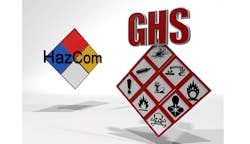Adhesive Supplier Beats OSHA’s HCS Deadline with Strategic Planning
When OSHA adopted Hazard Communication Standard (HCS), 29 CFR 1910.1200, its main purpose was to bring the United States into alignment with the United Nations’ Globally Harmonized System of Classification and Labeling of Chemicals (or GHS for short).
The revised standard requires that information about chemical hazards be conveyed on product labels. The labels must provide instructions about how to handle the product so that users can protect themselves. In addition, the labels must include red pictograms to visually depict the hazards associated with the product.
As reported here in MH&L in December 2015 (“Chemical Firms are Unprepared for GHS Regulations”), 65% of companies surveyed stated they needed another 6-12 months in order to be ready for compliance.
Meeting the new standard proved equally challenging for a 25-person company supplying pre-mixed and frozen adhesives.
The new standard affected all areas of the business and included training people about the standard, collecting the required information on over 1,000 raw materials, developing 500+ SDS (safety datasheet) product labels, and tracking customer requests for SDS and fulfillment of those requests.
To make the process easier to handle internally, a team of three people assumed responsibility for the project, which was broken down into five areas of scope: Collecting the required SDS information on raw materials. Producing new SDS. Tracking and fulfilling customer requests for SDS. Sourcing new label stock. Creating product labels to meet the new standard.
Step #1: Gather required SDS information.
The new OSHA standard requires that chemical suppliers change from the current MSDS (material safety data sheet) format to the new SDS format. The new SDS includes 16 sections that have to be configured to exact OSHA specifications versus the older MSDS, which had an ambiguous number of sections that could be in any format.
Part of the HCS was to show due diligence in contacting the material suppliers. This part of the process was time-consuming and daunting, and it required strict recordkeeping, as many companies didn’t yet have the information needed for the SDS.
To keep track of all the information collected, multiple databases were created. These databases housed customer/vendor date of requests and the date of fulfillment for the new SDS, customer information required on the labels, as well as pictograms and hazard statements associated with each adhesive.
Steps #2-3: Create the new SDS/Track customer requests.
Gathering the information needed to create the SDS took one person over a year. A huge boost came in January 2015 when major raw material suppliers adopted the SDS format.
When SDS information for all the raw materials in a formulation was obtained, a new SDS was created. The new SDS was emailed immediately if requested by a customer or sent with the customer’s next order.
This proactive approach reduced the workload for customer service as 80% of customer requests for new SDS could be met immediately.
Step #4: Source new label stock.
The new HCS standard specifies that all product labels include red diamond pictograms on white stock. Previous to the standard change, product labels were printed in one color (black) on silver label stock.
The challenge was finding new label stock that met three crucial requirements: The label adhesive had to bond to packaging subjected to temperatures <-40°C. (Many adhesives don’t bond well at low temperatures.) The label stock had to adhere to the over 25 types of materials used to package the product. The ink used on the stock couldn’t smear during the freeze-thaw cycle.
Several printers and over 20 different label stocks were tested on all packaging types at extreme temperatures and humidity conditions before one was finally chosen.
Step #5: Fitting SDS information on very small labels.
The new OSHA standard stipulates that product labels for hazardous chemicals contain eight pieces of information: The supplier’s name, address, and telephone number; the product identifier; signal word (e.g., “danger” and “warning”); hazardous statement(s); precautionary statement(s); and the pictograms, which have to be printed in red.
In addition, the information on the label has to be readable, even on the smallest syringe, which is 5 cm long x 1 cm in diameter.
The challenge was to meld all the stored information onto very small labels. Since every formula is unique, storage is time sensitive and lot traceability is important, label templates needed to be flexible enough to meet every customer’s need.
Although each adhesive formula has unique hazards, careful design would allow a single template to be used for many formulas. Still, approximately 100 unique label templates were created. Because the sections on the label required differing amounts of data (e.g., precautionary statements), the labels couldn’t be formatted with standard fields sizes.
These templates were linked to 500 formulas, which needed internal labeling, and 850 different products.
Result: Deadline met one month before June 1, 2015
The initial planning paid off, as did the strict attention to due diligence. Appli-Tec was ready to ship HCS-compliant materials a month before the June 1, 2015 deadline.
As a result of meeting the new OSHA standard, Appli-Tec has significantly stepped up its compliance game, which includes a dynamic SDS system with review triggers to ensure compliance.
In addition, Appli-Tec can now accommodate additional customer requests, such as adding 2-D barcodes, which contain customer-specific information, to labels. Product-specific color identifiers can also be used to differentiate syringes that may be stored alongside other adhesive formulas or to highlight information the customer believes is important for their process.
Today, customers can search Appli-Tec’s website for their specific SDS, a benefit that adds convenience while saving both the customer and Appli-Tec time. Everything shipped comes with a GHS compliant SDS and a properly labeled package—significantly reducing risk with regard to the handling adhesives.
Tim Walsh is president of Appli-Tec Inc., a Salem, N.H.-based supplier of pre-mixed and frozen adhesives for the aerospace, defense, semi-conductor and medical device industries. In business since 1983, the company is AS 9100 and ISO 9001 certified.
